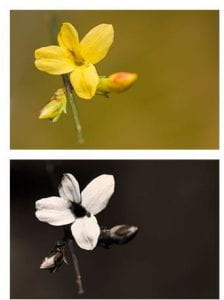By Brooke Moore, New Windsor, Senior Master Gardener Volunteer
This article appeared in the September 2019 Issue of Gardening in Orange County. Click here to subscribe!
We live in a colorful world filled with plants, animals, and objects that are brightly colored or, in some cases, patterned, or even singular in color. As humans we often think that the rest of the world sees itself and its surroundings in the same way that we do. But nothing could be further than the truth.
![Dan-yell [CC BY-SA 3.0 (https://creativecommons.org/licenses/by-sa/3.0)] A cirlce filled with dots of varying sizes all in arying shade of red except for the green dots, of varying shades, that form a large 'W' spaning the width of the circle.](https://blogs.cornell.edu/master-gardeners-cce-oc/files/2019/08/Ishihara-Test.svg-300x300.png)

Learning more about how he saw the world and experienced paintings, gardens and simple things like traffic lights began my interest in color and how we can manipulate our surroundings based on adding or subtracting colors from a situation.

The animals who live among us and in our gardens perceive color in many different ways, and they interact with the plants we grow depending on what they see and how they see and interpret light.
All eyes use reflected light to create images that are the basis of sight. As humans, we have sight that can determine the shape, size and special relationship of objects, and we have sight that is color-based.

The same is true for animals. Birds have keen color sight that helps them with foraging for food, identifying prey and recognizing others of their species. Many scientists have been astonished to discover that some birds may not be able to see all the colors of their own plumage, while other birds can see more than enough colors to find and attract a mate.
Bird Vision

Birds see more colors than humans as they are able to use ultraviolet (UV) light due to having four types of cones in their retinas – in contrast to humans who have three types of cones. Different species of birds have more or fewer cone cells in their retinas and thus different ability to see colors. The ability to determine subtle differences in shades of colors is an evolving ability in birds and thought to be something that aids in adapting to change in environment and availability of food sources.
| State | Types of cone cells | Approx. number of colors perceived | Carriers |
| Monochromacy | 1 | 200 | Marine mammals, owl monkey, Australian sea lion, achromat primates |
| Dichromacy | 2 | 40,000 | Most terrestrial non-primate mammals, color blind primates |
| Trichromacy | 3 | 10 million | Most primates, especially great apes (such as humans), marsupials, some insects (such as honeybees) |
| Tetrachromacy | 4 | 100 million | Most reptiles, amphibians, birds and insects, rarely humans |
| Pentachromacy | 5 | 10 billion | Some insects (specific species of butterflies), some birds (pigeons for instance) |
The UV reflection from the waxy surface of fruits and berries makes them stand out from the green of foliage – and birds are better able to find them. Red berries are seen best and will be eaten first, so also growing some plants that produce orange or yellow fruit will extend the feeding season.

Many insects also reflect UV light, making them more attractive to birds as a food source. Certain bird eggs reflect UV light and help birds to identify their own eggs and reject those put in the nest by other birds. Many flowers have nectar guides that reflect UV light. These marking are visible to bees and butterflies allowing them to easily find the nectar at the center of the flower.
Deer have poor color vision limited to short (blue) and middle (green) wave lengths of color. They may have some UV sensitivity but not much compared to birds. Foxes do not see green and have little ability to see blue, red or yellow. So, these animals are not using color in the garden to find or choose what they eat!
![U.S. Fish and Wildlife Service Headquarters [Public domain] The head of a deer standing with its face brushing up againsta purple flower.](https://blogs.cornell.edu/master-gardeners-cce-oc/files/2019/08/Sitka_black-tailed_deer_with_fireweed_6954233156-300x300.jpg) Understanding which animals use color to find and choose food can help us in identifying plants to put into our gardens, and plants to leave out. It also can put to rest myths like deer choosing red tulips over yellow daffodils -because they are making a choice based on taste and smell, not sight.
Understanding which animals use color to find and choose food can help us in identifying plants to put into our gardens, and plants to leave out. It also can put to rest myths like deer choosing red tulips over yellow daffodils -because they are making a choice based on taste and smell, not sight.
